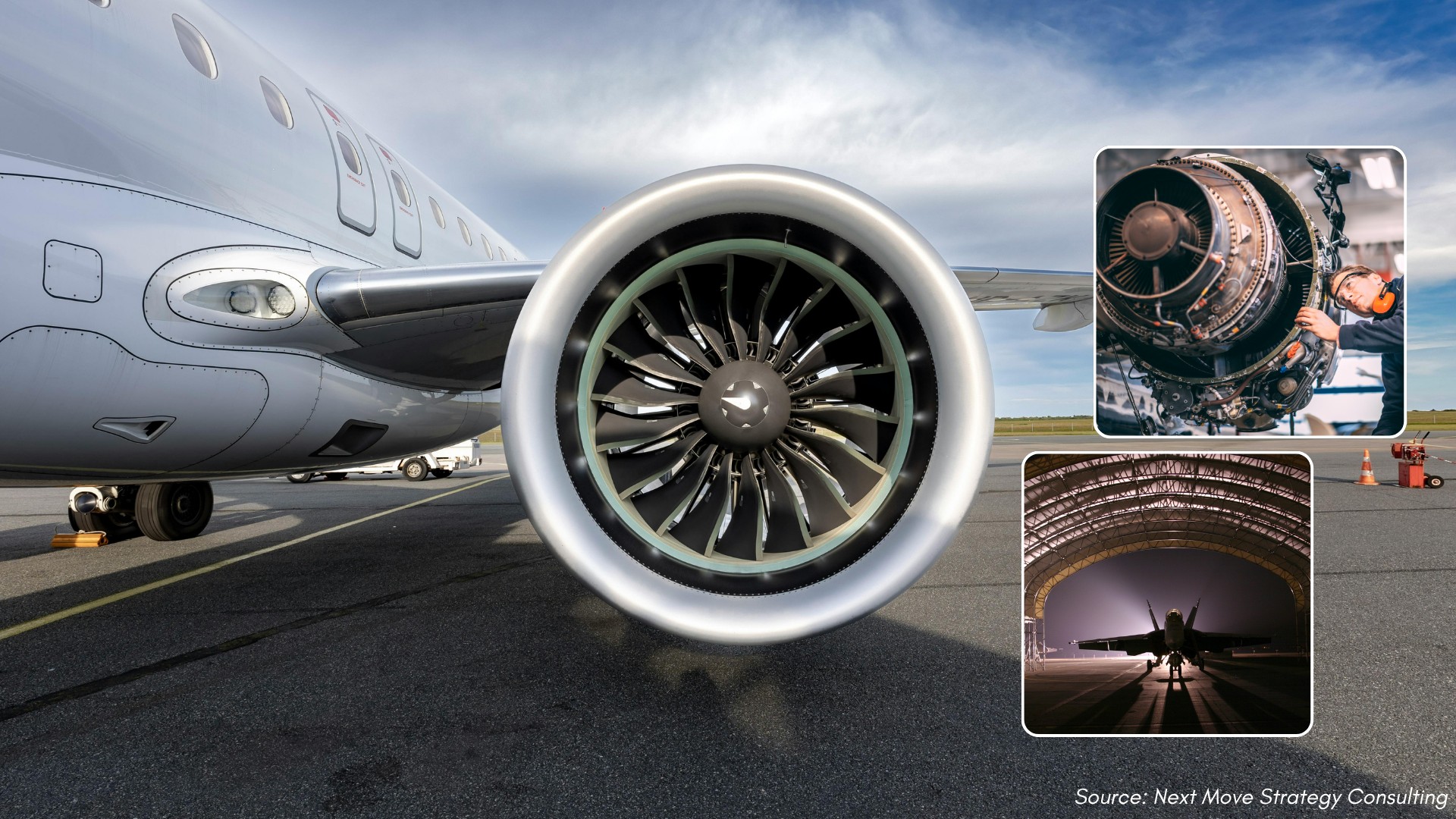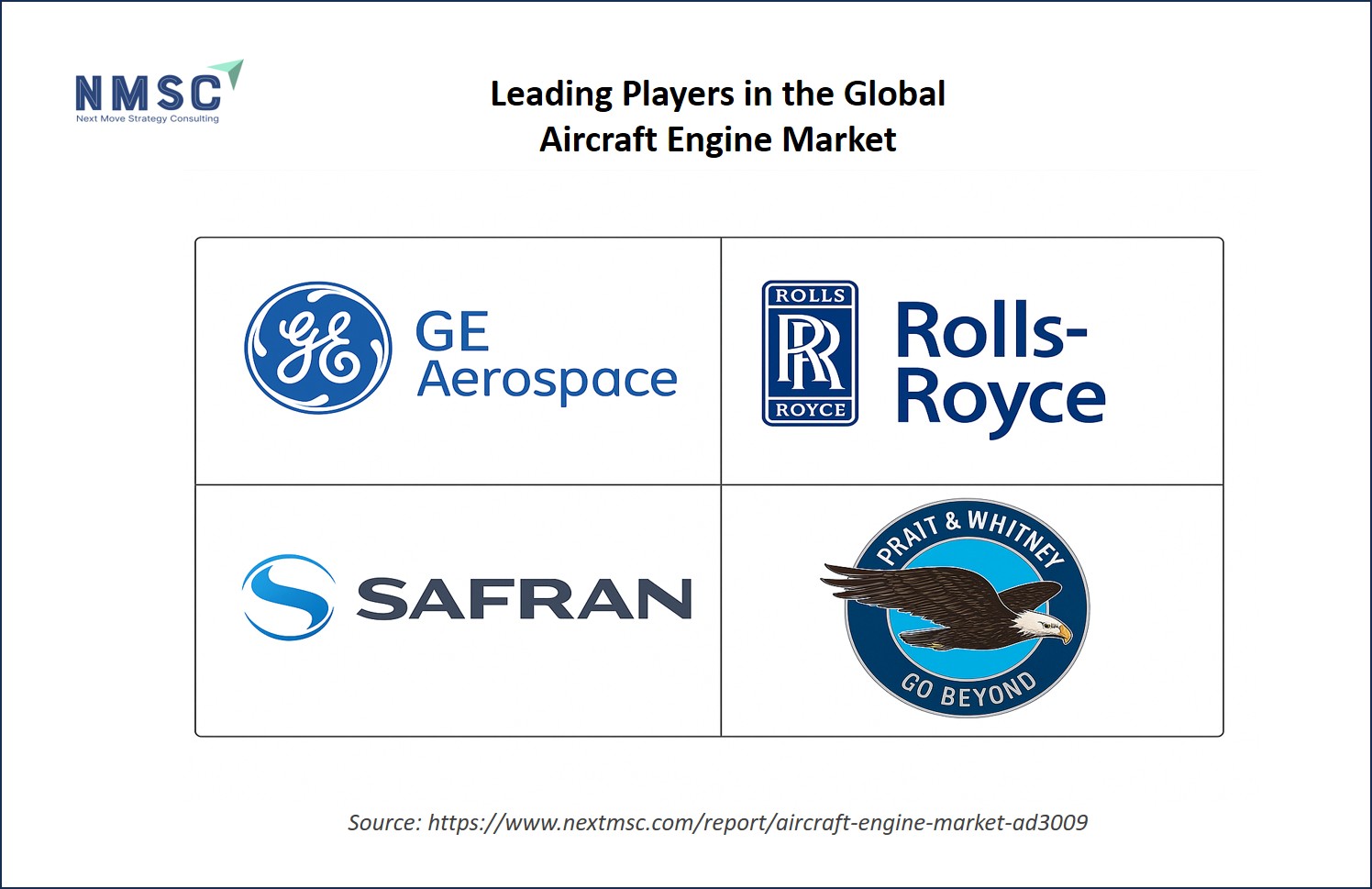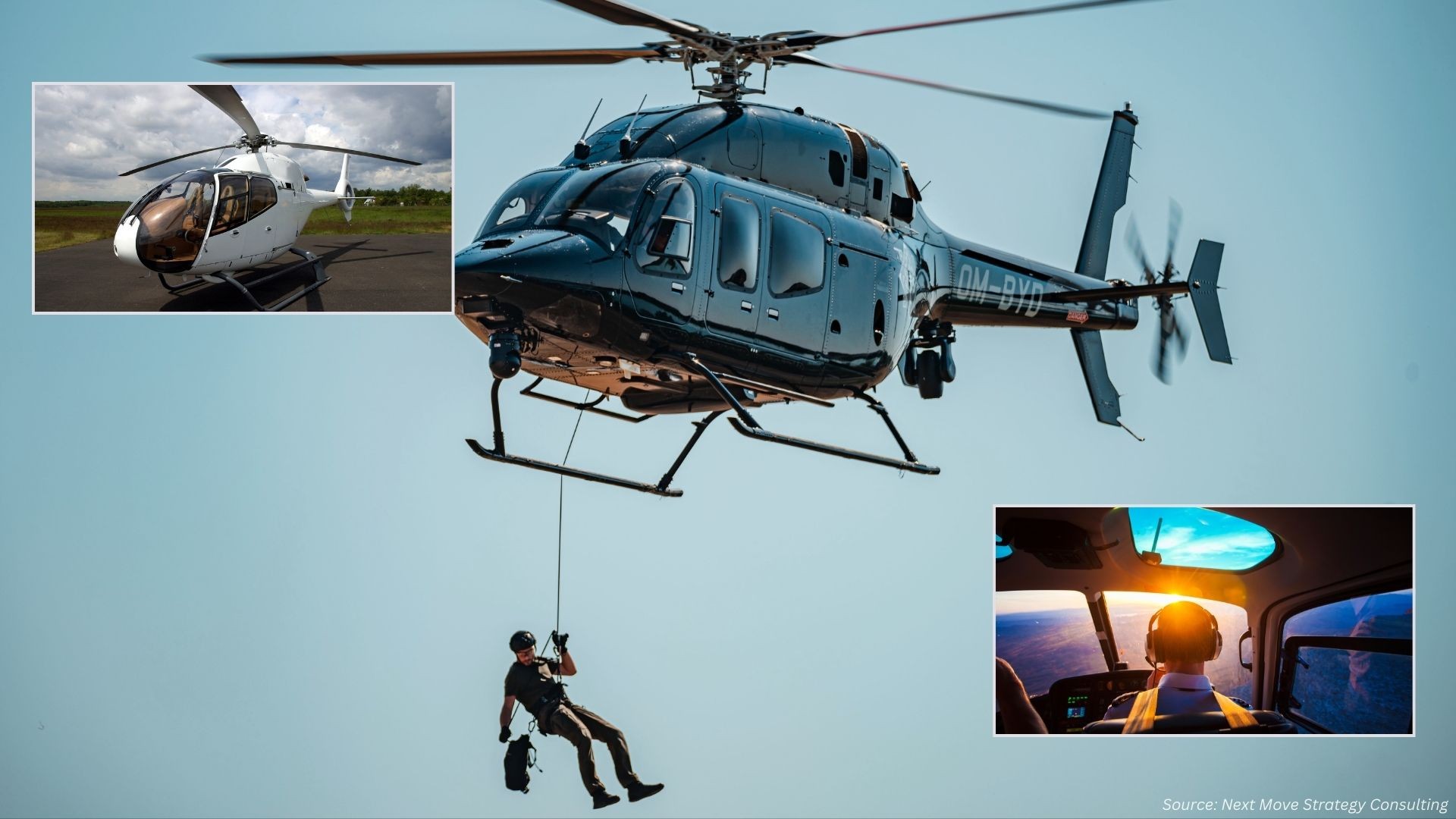Leading Players in the Aircraft Engine Market: Powering the Skies in 2024–2025
Published: 2025-09-10

The worldwide Aircraft Engine Market is soaring, driven by rising air travel, military modernization, and a push for sustainable aviation. In 2024, this industry is valued at approximately USD 67.94 billion and is projected to grow at a compound annual growth rate (CAGR) of 9.8% through 2034, reaching USD 118.89 billion.
But who are the key players steering this high-flying sector? Let’s dive into the companies shaping the future of aviation propulsion, their innovations, and what sets them apart.
Why the Aircraft Engine Market Matters
Aircraft engines are the heart of aviation, converting energy into thrust to propel planes through the skies. From commercial jets to military fighters, these powerhouses are critical for performance, efficiency, and sustainability. With global air travel demand surging, Airbus forecasts a need for 43,420 new passenger and freighter aircraft over the next 20 years.
The leading players are not just building engines; they’re redefining aviation’s future with fuel-efficient, eco-friendly technologies.
Key Market Drivers:
-
Rising Air Travel: Growing middle classes in Asia-Pacific and increased urbanization fuel demand for new aircraft.
-
Military Modernization: Geopolitical tensions drive investments in advanced fighter jet engines. Turkey and South Korea surge ahead in indigenous jet engine development. Turkey has reportedly invested $3-5 billion to the development of the TF-35000 engine for its ambitious Kaan fighter jet, while South Korea is investing $2.3 billion in an indigenous engine for its KF-21 Boramae program. These steps highlight their strategic foresight and commitment to self-reliance in defense technologies. Both nations are positioning themselves as formidable players in the aerospace industry, particularly in the realm of fifth-generation fighter jets.
-
Sustainability Push: Innovations like sustainable aviation fuel (SAF) and hybrid-electric engines are gaining traction. SAF, made from renewable sources like waste oils and agricultural residues, can cut greenhouse gas emissions by up to 80% and works in existing aircraft. For SAF to effectively support aviation decarbonization, strong global policies are vital. The EU, US, and UK have introduced SAF mandates and incentives—like the EU’s 70% SAF goal by 2050, and the US’s 35 billion gallons target. The UK begins with 2% SAF in 2025, aiming for 10% by 2030 and 22% by 2040, supported by market incentives and revenue guarantees. The industry must pair SAF with technological innovations—like hybrid-electric engines and fuel optimization—to scale adoption and truly advance toward net-zero aviation.
Top Players in the Aircraft Engine Market
The market is highly consolidated, with a few giants dominating due to their technological prowess and strategic partnerships. Below, we explore the leading companies focusing on their market share, key products, and innovations.
1. General Electric (GE Aerospace)
-
GE9X, Powering the Boeing 777X with Advanced Technology: GE Aerospace is a titan in the aircraft engine market, known for its cutting-edge turbofan engines. The GE9X, purpose-built for the Boeing 777X, is the largest and most powerful commercial aircraft engine, drawing on extensive experience from the GE90 and GEnx. Incorporating advanced technologies, it offers superior fuel efficiency, reliability, and quieter operation with lower emissions, making it the most efficient engine in its class for enhanced performance and sustainability.
-
Investment in Innovation: In February 2024, GE invested USD 11 million to transform its Singapore repair facility at Seletar Aerospace Park into a into a “state-of-the-art Smart Factory”, in partnership with the Singapore Economic Development Board. The facility, a global leader in additive manufacturing for jet engine airfoil repairs, will enhance technologies for GEnx and CFM LEAP engines, extending to CFM56 and CF34 models. The upgrade includes automated inspection systems, innovative material removal processes, and digitalization with IoT, robotics, cloud storage, and data analytics. This investment, expanding to two Loyang Industrial Park plants, aims to meet rising component demand, boost workforce skills, and strengthen Singapore’s position in aerospace MRO innovation.
GE Aerospace, thus, leads with its technological innovation and strategic investments, solidifying its dominance in commercial aviation.
2. Rolls-Royce Holdings plc
-
Trent XWB-97: Rolls-Royce has secured an order for 50 Trent XWB-97 engines to power 25 Airbus A350-1000 aircraft for Riyadh Air, Saudi Arabia’s new national carrier, as announced at the 2025 Paris Air Show. A Memorandum of Understanding was also signed for Rolls-Royce’s TotalCare service, ensuring comprehensive maintenance and operational support for the engines. The Trent XWB-97, known as the world’s most efficient large aero-engine, will support Riyadh Air’s goal of connecting to over 100 global destinations by 2030, aligning with Saudi Vision 2030 to enhance Riyadh’s global connectivity.
-
Partnerships: Signed a seven-year deal with Azad Engineering in January 2024 to to manufacture critical components for its defense aircraft engines. This strategic collaboration propels Azad Engineering into the global supply chain for Rolls-Royce’s advanced aero engines, marking a significant leap for India in defense manufacturing.
-
Sustainability Focus: Rolls-Royce has successfully completed compatibility testing of 100% Sustainable Aviation Fuel (SAF) on all its in-production civil aero engine types.
Rolls-Royce excels in widebody engines and is expanding its footprint through global partnerships and sustainable innovations.
3. Safran Aircraft Engines
Safran, a French leader, is a key player through its CFM International joint venture with GE. It focuses on fuel-efficient engines like the LEAP-1A, developed by CFM International which powers Airbus A320neo family. It delivers a 15% reduction in fuel consumption and CO2 emissions and up to 50% lower NOx emissions compared to previous-generation engines, offering enhanced efficiency and environmental performance for single-aisle jets.
-
LEAP Engines
-
In January 2024, During French President Emmanuel Macron's state visit to India, Akasa Air and CFM International, a joint venture between GE Aerospace and Safran Aircraft Engines, announced an agreement for over 300 CFM LEAP-1B engines to power 150 Boeing 737 MAX aircraft, ordered the previous week at Wings India.
-
The deal, valued at approximately $5 billion, includes spare engines and a services contract to ensure operational reliability and safety. The LEAP engine family, known for its industry-leading fuel efficiency, has logged over 45 million flight hours and 18.7 million flight cycles since 2016, saving over 30 million tons of CO2 compared to previous-generation engines. This order strengthens CFM’s presence in India, with over 400 CFM-powered aircraft in service and 2,500 LEAP engines in the backlog, supporting Akasa Air’s goal to be among the top 30 global airlines by 2030.
-
-
MRO Investment: In October 2024, Safran announced an investment plan of more than €1 billion for the development of its global maintenance, repair and overhaul (MRO) network to support the growing fleet of LEAP engines around the world.
-
Innovation: Safran is unveiling the M88 T-REX, an evolution of its M88 engine. Compatible with future standards of the Dassault Aviation Rafale, this engine will build on the proven reliability and performance of the M88, while taking it to new limits with a thrust increase to 9 metric tons with afterburner. The improved low-pressure compressor will allow greater airflow intake.
-
“We’re proud to be launching this engine project, which will push the boundaries of the M88’s performance to meet the evolving needs of our armed forces customers in an increasingly unstable geopolitical context,” said Christophe Bruneau, EVP Military Engines, Safran Aircraft Engines. “Development of the M88 T-REX will also enable us to expand our technology portfolio, benefiting our entire product range and strengthening national sovereignty.”
-
Safran is currently conducting risk reduction studies ahead of the engine’s development. Qualification of the M88 T-REX is aligned with the planned entry into service of the Rafale F5 standard.
Safran’s focus on fuel-efficient engines and robust MRO capabilities makes it a formidable competitor in the commercial aviation sector.
4. Pratt & Whitney (RTX Corporation)
-
RTX’s Pratt & Whitney is a major player known for its geared turbofan (GTF) engines, which offer superior fuel efficiency and lower emissions. "We continue to see strong demand for the GTF engine, as evidenced by the large number of orders we've received only halfway into the year," said Rick Deurloo, president of Commercial Engines at Pratt & Whitney. "These orders demonstrate confidence in Pratt & Whitney and the value the GTF delivers to customers with its industry-leading fuel efficiency. We will continue to build on this with the entry into service next year of the GTF Advantage, which received FAA type certification earlier this year and will provide even more range capability, better fuel efficiency and enhanced durability."
-
The GTF powers approximately 2,400 aircraft for over 85 customers worldwide. The recently FAA-certified GTF Advantage, set for 2026 entry, will enhance range, fuel efficiency, and durability, while the GTF Hot Section Plus (HS+) option nearly doubles time on wing.
-
The engine’s geared architecture, projected to reach 250 million flight hours by the mid-2030s, supports next-generation technologies for the single-aisle market.
-
Pratt & Whitney has a history of partnering with NASA on various projects. For instance, the was selected by NASA to develop advanced engine technologies to reduce fuel consumption and emissions for next generation single-aisle aircraft. The Hybrid Thermally Efficient Core (HyTEC) project is part of NASA’s Sustainable Flight National Partnership, which will enable breakthrough innovations in support of the aviation industry’s goal to significantly reduce CO2 emissions by 2050.
Through HyTEC Pratt & Whitney will demonstrate the compatibility of sustainable aviation fuels (SAFs) with advanced combustors for small core engines. The project includes developing and testing the fuel and air mixers for optimal efficiency and then measuring the emissions and noise emitted using Jet A fuel and high blends of SAF.
Pratt & Whitney’s strategic collaborations position it as a leader in sustainable aviation solutions.
Market Trends and Competitive Landscape
The aircraft engine market is shaped by several trends in 2024–2025:
-
Fuel Efficiency and Sustainability: Companies are investing in SAF and hybrid-electric technologies to meet stringent emissions regulations.
-
Military Demand: Geopolitical tensions drive orders for advanced engines, like the worth more than 260 billion rupees or US$3.1 billion deal for Russian-designed Sukhoi Su-30MKI, and the country recently ordered 240 engines to keep the fleet airborne for years to come. Officials signed a deal with state-owned Hindustan Aeronautics Limited (HAL) to supply the so-called AL-31FP engines. The company plans to boost the ratio to 63% by tapping India’s defense manufacturing ecosystem.
-
Regional Growth: North America dominates the aircraft engine market share and is expected to hold the largest share during the forecast period. This is due to the growth of the military industry that accelerates the demand for advanced aviation engine to enhance performance, efficiency and accommodate contemporary military capabilities in the region.
Competitive Insights:
The market is highly competitive, with leading players leveraging innovation and partnerships to maintain dominance amid rising demand. The industry comprises of various market players such as Mitsubishi Heavy Industries, Ltd., Honeywell International Inc., General Electric Company, Rolls-Royce Holdings plc, Safran S.A., Textron Inc., Hanwha Group, ZeroAvia, Inc., MTU Aero Engines AG, Pratt & Whitney Inc., CFM International, Rotax GmbH & Co KG, Continental Aerospace Technologies, Lycoming Engines and others. These market players continue to adopt various market development strategies including product launches to maintain their dominance in the market.
Challenges Facing Leading Players
Despite the growing success, this industry faces significant hurdles. The high cost of development of commercial aircraft engines acts as a strong constraint, as the large amount of investment is needed for research, testing and manufacturing restricts new entrants and hinders innovation within the market.
Next Steps for Stakeholders
To stay competitive in the aircraft engine market, stakeholders can take these actionable steps:
|
Strategy |
Description |
|
Invest in R&D |
Prioritize funding for sustainable technologies, like SAF (Sustainable Aviation Fuel) and hybrid-electric engines to meet future regulations. |
|
Expand MRO Networks |
Invest in global Maintenance, Repair, and Overhaul (MRO) facilities to support growing fleets. |
|
Forge Strategic Partnerships |
Collaborate with regional manufacturers to strengthen supply chains and boost production capabilities. |
|
Monitor Asia-Pacific Growth |
Target emerging markets like China and India for new contracts and investments, capitalizing on the region's growth. |
|
Adopt Digital Tools |
Implement AI and predictive analytics for inventory management, maintenance, and operational efficiency. |
About the Author
 Sneha Chakraborty is a seasoned SEO Executive and Content Writer with over 4 years of experience in the digital marketing space, bringing a strong command of online visibility strategies and a keen insight into the evolving digital landscape. She specializes in enhancing online visibility and user engagement through data-driven strategies and creative content solutions. She has been closely observing trends across various industry domains, bringing insightful perspectives into her writing. Sneha is passionate about translating complex digital concepts into accessible content for a wide audience. Outside of work, she enjoys reading, sketching, and exploring the outdoors through nature photography.
Sneha Chakraborty is a seasoned SEO Executive and Content Writer with over 4 years of experience in the digital marketing space, bringing a strong command of online visibility strategies and a keen insight into the evolving digital landscape. She specializes in enhancing online visibility and user engagement through data-driven strategies and creative content solutions. She has been closely observing trends across various industry domains, bringing insightful perspectives into her writing. Sneha is passionate about translating complex digital concepts into accessible content for a wide audience. Outside of work, she enjoys reading, sketching, and exploring the outdoors through nature photography.
About the Reviewer
 Debashree Dey is a skilled Content Writer, PR Specialist, and Assistant Manager with strong expertise in Digital Marketing. She specializes in crafting visibility strategies and delivering impactful, data-driven campaigns. Passionate about creating engaging, audience-focused content, she helps brands strengthen their online presence. Beyond work, she draws inspiration from creative projects and design pursuits.
Debashree Dey is a skilled Content Writer, PR Specialist, and Assistant Manager with strong expertise in Digital Marketing. She specializes in crafting visibility strategies and delivering impactful, data-driven campaigns. Passionate about creating engaging, audience-focused content, she helps brands strengthen their online presence. Beyond work, she draws inspiration from creative projects and design pursuits.















Add Comment